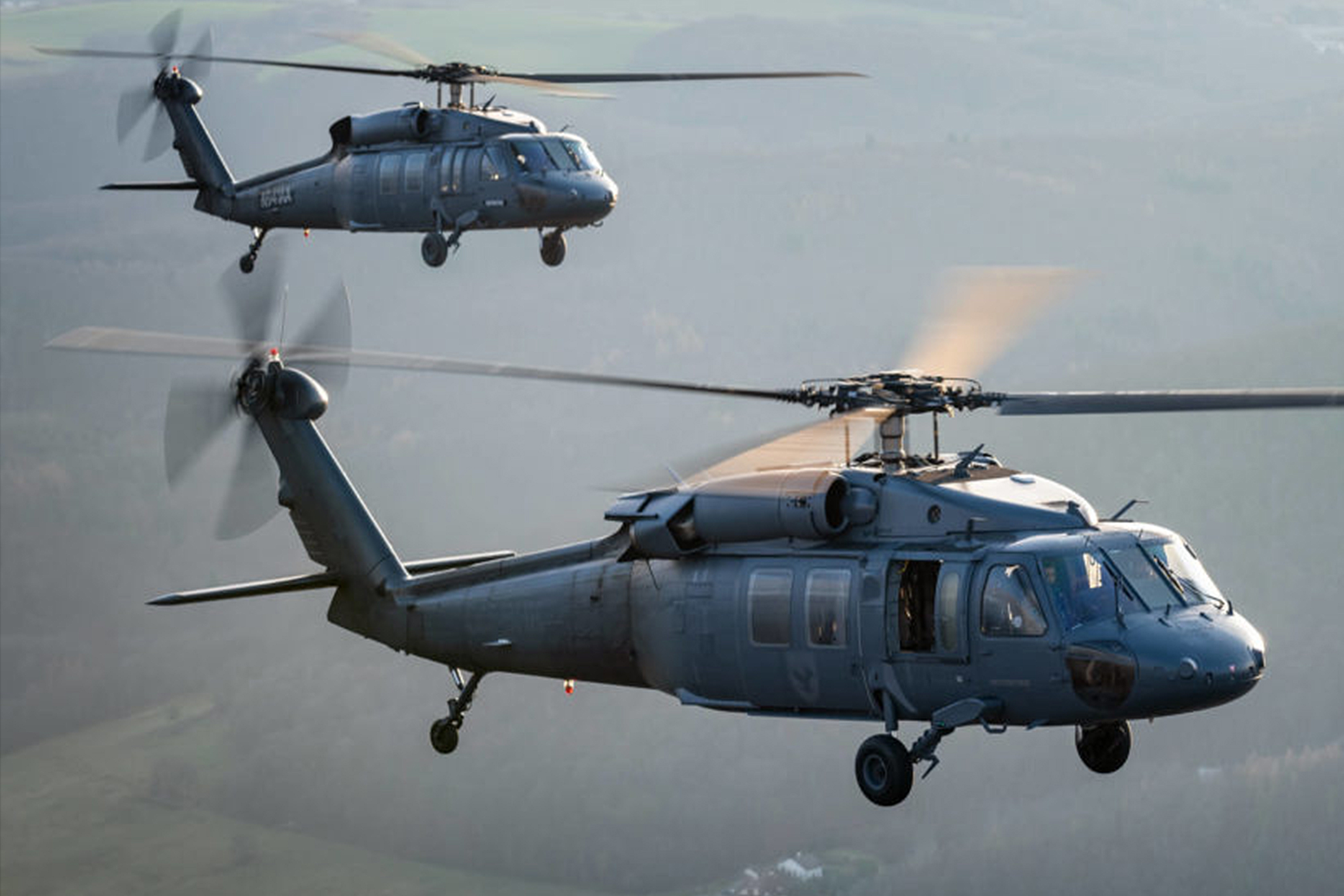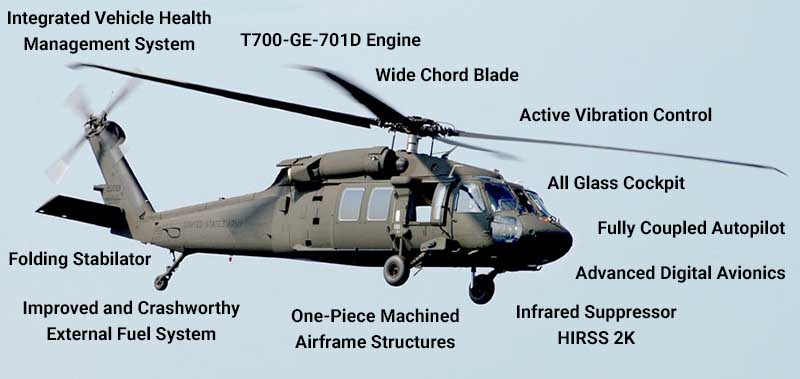UH-60: Technologies in Modern Helicopter Style
The UH-60 helicopter stands as a benchmark in contemporary aviation, showcasing substantial innovations in style and modern technology that provide to the progressing demands of army operations. As we discover the evolution and crucial advancements of the UH-60, it becomes essential to consider how these growths influence not only existing applications but likewise the future landscape of helicopter layout.

Advancement of the UH-60
The advancement of the UH-60 Black Hawk helicopter represents a substantial turning point in aerospace engineering and army aviation. Presented in the late 1970s, the UH-60 was developed by Sikorsky Airplane to meet the USA Military's requirement for a versatile energy helicopter efficient in doing a variety of objectives. Its design stressed maneuverability, sturdiness, and rate, establishing brand-new criteria for functional efficiency.
The UH-60 includes a distinct four-blade blades system, which enhances lift and stability, enabling it to operate successfully in diverse atmospheres. Its airframe is built from sophisticated composite products, adding to a reduction in weight while maintaining architectural honesty. The helicopter's layout likewise integrates improved aerodynamics, which enhances gas performance and boosts range.
For many years, the Black Hawk has undertaken multiple upgrades to improve its abilities, including improved engines, progressed trip control systems, and modular systems for simple upkeep and versatility. The helicopter's capability to execute goals ranging from army transportation to clinical evacuation has actually strengthened its duty as a foundation of U.S. armed forces operations. The UH-60 Black Hawk remains an archetype of just how innovation in helicopter design can substantially influence army efficiency and operational versatility.
Advanced Avionics Solutions
Innovations in avionics systems have actually changed the capacities of modern-day helicopters like the UH-60 Black Hawk, boosting functional effectiveness and situational awareness (UH 60). The assimilation of innovative avionics permits boosted navigating, communication, and flight monitoring, making the UH-60 extra flexible in varied objective profiles
Among the key attributes is the innovative digital cabin, which employs multifunction display screens that offer real-time information, making certain pilots have immediate accessibility to essential flight details. This streamlining of details minimizes pilot work and improves decision-making procedures during complex procedures. Furthermore, the unification of GPS and inertial navigating systems enables specific positioning and path planning, enhancing goal execution in challenging settings.
Furthermore, advanced avionics systems boost interaction abilities via safe data links and voice interaction systems, allowing seamless coordination with ground pressures and various other aircraft. The integration of automatic trip control systems better adds to boosted stability and control, particularly in unfavorable weather conditions or during low-altitude maneuvers.
Engine and Efficiency Enhancements
Engine performance in modern helicopters has actually taken a significant jump onward, driven by innovations that boost dependability, efficiency, and power. At the forefront of these advancements is the fostering of more powerful turboshaft engines, specifically those using innovative products and innovations that enable greater temperature level tolerances and increased drive abilities. The UH-60 Black Hawk, as an example, makes use of the T700-GE-701C engine, which features a dual-channel, full-authority digital engine control system. This system enhances efficiency while optimizing gas usage my latest blog post and minimizing maintenance requirements.
Moreover, the assimilation of engine wellness monitoring systems permits real-time diagnostics and predictive upkeep, significantly boosting operational dependability. These systems not just sharp teams to possible issues before they end up being essential yet additionally assist in a lot more effective upkeep organizing, thereby reducing downtime.

Materials and Structural Innovations
Current growths in materials and architectural style have changed modern-day helicopter construction, click site boosting both performance and durability. The intro of innovative composite materials, such as carbon fiber reinforced polymers, has actually considerably reduced weight while preserving structural integrity. This change not just boosts gas efficiency however likewise enhances payload ability, permitting helicopters like the UH-60 to perform more varied goals.
Furthermore, advancements in light weight aluminum alloys and titanium parts have actually contributed to boosted resistance to rust and fatigue, expanding the life expectancy of vital airframe components. The tactical usage of these materials has brought about a decrease in maintenance needs and boosted overall functional preparedness.

Additionally, the assimilation of computer-aided layout (CAD) and additive manufacturing technologies has actually enabled much more complicated geometries and lightweight frameworks, optimizing the aerodynamic performance of helicopter layouts. These innovations assist in rapid prototyping and production, allowing makers to respond promptly to progressing mission requirements.
Safety and Survivability Attributes
Safety and security and survivability features in modern-day helicopter design have actually become paramount, mirroring the enhancing needs news for mission effectiveness in difficult environments. The UH-60 Black Hawk, a noteworthy example, incorporates advanced innovations to improve crew and traveler security. Among the most vital improvements is the unification of crashworthy gas systems developed to lessen the danger of fire during effect. In addition, the airframe is constructed with strengthened materials that dissipate and absorb power, more safeguarding residents in the event of a crash.
The helicopter likewise uses a ballistic defense system, which includes armored team seats and essential systems shielding, minimizing susceptability to tiny arms fire and shrapnel. Enhanced situational recognition is achieved via innovative avionics and sensor modern technologies, permitting pilots to spot and stay clear of hazards efficiently.
Furthermore, the assimilation of redundancy in important systems-- such as dual engines and numerous trip control networks-- makes certain ongoing operation also if one system stops working. The UH-60 is geared up with advanced emergency situation flotation tools, boosting survivability in water touchdowns. Jointly, these features not only boost the safety of workers yet also increase objective success rates in hostile atmospheres, demonstrating the dedication to excellence in helicopter layout.
Verdict
The UH-60 helicopter represents a considerable advancement in modern-day aviation innovation, incorporating ingenious products, advanced avionics, and robust security features. Its evolution shows a commitment to improving performance and functional effectiveness while guaranteeing pilot and team survivability. The assimilation of lightweight compounds and progressed navigating systems highlights the helicopter's adaptability in numerous army goals. In general, the UH-60 serves as a criteria for future developments in helicopter design, symbolizing resilience and convenience in modern army operations.
The UH-60 helicopter stands as a benchmark in modern aeronautics, showcasing considerable improvements in layout and modern technology that cater to the progressing demands of army operations. As we explore the evolution and vital developments of the UH-60, it becomes necessary to take into consideration exactly how these developments influence not only current applications yet additionally the future landscape of helicopter layout.
Presented in the late 1970s, the UH-60 was created by Sikorsky Aircraft to meet the United States Army's demand for a functional utility helicopter capable of carrying out a variety of objectives. The UH-60 Black Hawk stays a prime instance of just how development in helicopter layout can significantly affect armed forces effectiveness and operational adaptability.
In general, the UH-60 offers as a criteria for future advancements in helicopter style, personifying durability and adaptability in modern army operations.
 Jennifer Grey Then & Now!
Jennifer Grey Then & Now! Devin Ratray Then & Now!
Devin Ratray Then & Now! Kenan Thompson Then & Now!
Kenan Thompson Then & Now! Kelly Le Brock Then & Now!
Kelly Le Brock Then & Now! Suri Cruise Then & Now!
Suri Cruise Then & Now!